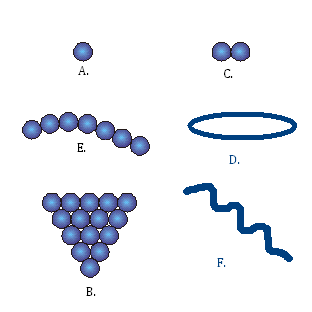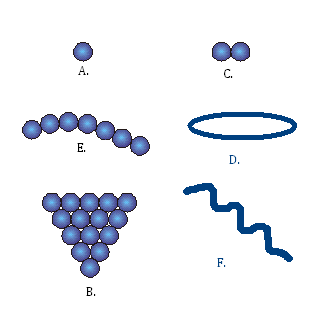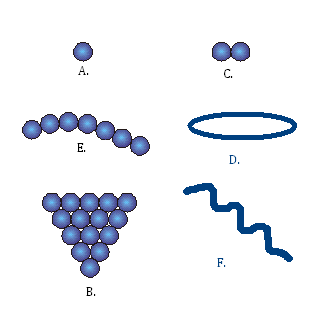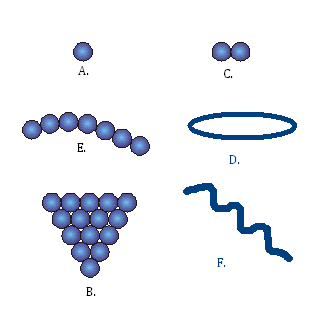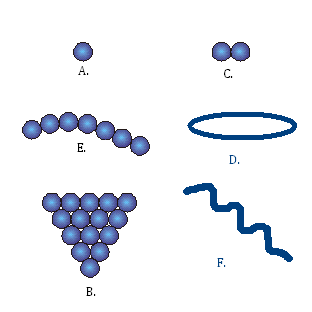A Quiz On Types Of Bacteria! Trivia
(64).jpg)
A quiz on types of bacteria! There are different types of bacteria around us and within us, but not all of them are bad as they play a specific function in the environment. Bacteria exist in millions and can’t be seen by the naked human eye; the growth of dangerous bacteria can be controlled by using antibiotics. Get to learn some more about these microscopic organisms by checking out the quiz.
- 1.
Members of this Kingdom live almost everywhere and have peptidoglycan in their cell walls.
- A.
Archaebacteria
- B.
Eubacteria
- C.
Protist
- D.
Fungi
Correct Answer
B. EubacteriaExplanation
Eubacteria is the correct answer because members of this kingdom are found in various habitats and environments, including soil, water, and even inside the human body. They have peptidoglycan in their cell walls, which is a characteristic feature of eubacteria. Archaebacteria, on the other hand, do not have peptidoglycan in their cell walls and are typically found in extreme environments. Protists and fungi are not bacteria and do not have peptidoglycan in their cell walls.Rate this question:
-
- 2.
Poisons released by some bacteria.
- A.
Vaccine
- B.
Toxin
- C.
Antibiotic
- D.
Immunity
Correct Answer
B. ToxinExplanation
Toxins are substances released by certain bacteria that can cause harm to the body. They can disrupt normal cellular function and lead to various symptoms and diseases. Vaccines, on the other hand, are substances that stimulate the immune system to produce a response against specific pathogens, including bacteria. Antibiotics are medications used to treat bacterial infections by killing or inhibiting the growth of bacteria. Immunity refers to the body's ability to resist and fight off infections. Given that the question is asking for the term that best describes "poisons released by some bacteria," the most appropriate answer is "toxin."Rate this question:
-
- 3.
Type of asexual reproduction used by bacteria.
- A.
Fusion
- B.
Binary fission
- C.
Sexual reproduction
- D.
Conjugation
Correct Answer
B. Binary fissionExplanation
Binary fission is the correct answer because it is the type of asexual reproduction used by bacteria. In binary fission, a single bacterium divides into two identical daughter cells, each with the same genetic material as the parent cell. This process allows bacteria to rapidly reproduce and increase their population. Conjugation and fusion involve the exchange of genetic material between two bacteria, while sexual reproduction involves the fusion of gametes from two different individuals. Therefore, binary fission is the most appropriate choice for the type of asexual reproduction used by bacteria.Rate this question:
-
- 4.
Disease-causing agent
- A.
Bacteria
- B.
Virus
- C.
Vaccine
- D.
Pathogen
Correct Answer
D. PathogenExplanation
A pathogen refers to any disease-causing agent, such as bacteria or viruses. It is a general term that encompasses various microorganisms or infectious agents that can invade the body and cause illness. Therefore, pathogen is the correct answer as it is the most inclusive term that encompasses both bacteria and viruses as disease-causing agents.Rate this question:
-
- 5.
Weakened or killed pathogen injected into the body to help with immunity.
- A.
Antibiotics
- B.
Toxin
- C.
Vaccine
- D.
Pathogen
Correct Answer
C. VaccineExplanation
A vaccine is a weakened or killed pathogen that is injected into the body. It helps to stimulate the immune system and build immunity against the specific pathogen. Unlike antibiotics, which are used to treat bacterial infections, vaccines are a preventive measure. They train the immune system to recognize and respond to the pathogen, so that if the person is exposed to the actual pathogen in the future, their immune system can quickly and effectively fight it off. Vaccines have been instrumental in controlling and eradicating many infectious diseases.Rate this question:
-
- 6.
Chemical compounds inhibit the growth of bacteria.
- A.
Disinfectant
- B.
Cleaner
- C.
Antibiotics
- D.
Vaccines
Correct Answer
C. AntibioticsExplanation
Antibiotics are chemical compounds that are specifically designed to inhibit the growth of bacteria. They work by either killing the bacteria or preventing them from multiplying. Unlike disinfectants, which are used to kill bacteria on surfaces, antibiotics are used to treat bacterial infections within the body. Cleaners, on the other hand, are used to remove dirt and impurities from surfaces and do not necessarily have antibacterial properties. Vaccines, while effective in preventing certain bacterial infections, do not directly inhibit the growth of bacteria.Rate this question:
-
- 7.
Body's ability to destroy pathogens.
- A.
Antibiotics
- B.
Disinfectant
- C.
Toxins
- D.
Immune system
Correct Answer
D. Immune systemExplanation
The immune system is the body's defense mechanism against pathogens, such as bacteria, viruses, and other harmful microorganisms. It is responsible for recognizing and destroying these invaders to maintain the body's health. Unlike antibiotics, which specifically target and kill bacteria, the immune system has a broader range of actions and can also neutralize toxins and other harmful substances. Disinfectants, on the other hand, are external agents used to kill or inhibit the growth of microorganisms on surfaces. Therefore, the immune system is the correct answer as it is the body's natural defense system against pathogens.Rate this question:
-
- 8.
Identify the bacteria shape for A: Word Bank: Diplococcus, Bacillus, Staphylococcus, Spirillum, Streptococcus, Coccus
Correct Answer
CoccusExplanation
The correct answer is Coccus. Coccus refers to a bacteria shape that is spherical or round in shape. It is a single-celled organism that can occur in various arrangements such as pairs (diplococcus), chains (streptococcus), clusters (staphylococcus), or groups of four (tetracoccus). This shape is commonly found in bacteria like Staphylococcus aureus, Streptococcus pneumoniae, and Neisseria gonorrhoeae.Rate this question:
- 9.
Identify the bacteria shape for B: Word bank: Diplococcus, Streptococcus, Staphylococcus, Bacillus, Coccus, Spirillum
Correct Answer
StaphylococcusExplanation
The correct answer is Staphylococcus. Staphylococcus is a type of bacteria that is characterized by its round shape, arranged in clusters. This shape is different from the other options given in the word bank, such as Diplococcus (arranged in pairs), Streptococcus (arranged in chains), Bacillus (rod-shaped), Coccus (spherical), and Spirillum (spiral-shaped). Therefore, Staphylococcus is the most appropriate choice for the bacteria shape for B.Rate this question:
- 10.
Identify the bacteria shape for C:Word Bank: Diplococcus, Staphylococcus, Coccus, Streptococcus, Spirillum, Bacillus
Correct Answer
DiplococcusExplanation
The correct answer is Diplococcus. Diplococcus is a bacteria shape characterized by two cocci (spherical cells) that are typically found in pairs. This arrangement can be seen in bacteria such as Neisseria gonorrhoeae, which causes the sexually transmitted infection gonorrhea. The term "diplo" means double, referring to the paired arrangement of the cocci.Rate this question:
- 11.
Identify the bacteria shape for D:Word Bank: Diplococcus, Streptococcus, Staphylococcus, Spirillum, Bacillus, Coccus
Correct Answer
BacillusExplanation
The correct answer is Bacillus. Bacillus refers to a bacteria shape that is rod-shaped or cylindrical. It is characterized by its elongated and cylindrical structure. This shape is commonly found in bacteria such as Bacillus anthracis, which causes anthrax.Rate this question:
- 12.
Identify the bacteria shape for E:Word Bank: Diplococcus, Streptococcus, Spirillum, Bacillus, Staphylcoccus, Coccus
Correct Answer
StreptococcusExplanation
Streptococcus is the correct answer because it is a type of bacteria that is characterized by its shape, which is chains or clusters of spherical cells called cocci. Streptococcus bacteria are commonly found in the throat and can cause infections such as strep throat.Rate this question:
- 13.
Identify the bacteria shape for F:Word Bank: Diplococcus, Streptococcus, Staphylococcus, Coccus, Spirillum, Bacillus
Correct Answer
SpirillumExplanation
The correct answer is Spirillum. Spirillum is a type of bacteria that has a spiral shape. It is characterized by a long, helical body with flagella for movement. Unlike other bacteria shapes such as cocci (spherical) or bacilli (rod-shaped), spirilla have a distinctive spiral appearance. They are often found in aquatic environments and can be pathogenic or non-pathogenic.Rate this question:
Quiz Review Timeline +
Our quizzes are rigorously reviewed, monitored and continuously updated by our expert board to maintain accuracy, relevance, and timeliness.
-
Current Version
-
Mar 21, 2023Quiz Edited by
ProProfs Editorial Team -
Mar 29, 2010Quiz Created by
Dmay
- Anatomy Quizzes
- Bio Quizzes
- Biological Evolution Quizzes
- Biology Exam Quizzes
- Biology Test Quizzes
- Cell Quizzes
- Cell Biology Quizzes
- Chapters Of Biology Quizzes
- Classical Conditioning Quizzes
- Conservation Biology Quizzes
- Enzyme Quizzes
- Fungi Quizzes
- General Biology Quizzes
- Genetics Quizzes
- Immunology Quizzes
- Macromolecule Quizzes
- Marine Biology Quizzes
- Mitosis And Meiosis Quizzes
- Molecular Biology Quizzes
- Parasitology Quizzes
- Physiology Quizzes
- Prokaryote Quizzes
- Protist And Fungi Quizzes
- Protozoa Quizzes
- Respiratory Quizzes
- Spine Quizzes
- Stem Cell Quizzes
- Taxonomy Quizzes
- Traits Quizzes
- Ultimate Biology Quizzes
- Zoology Quizzes
 Back to top
Back to top



